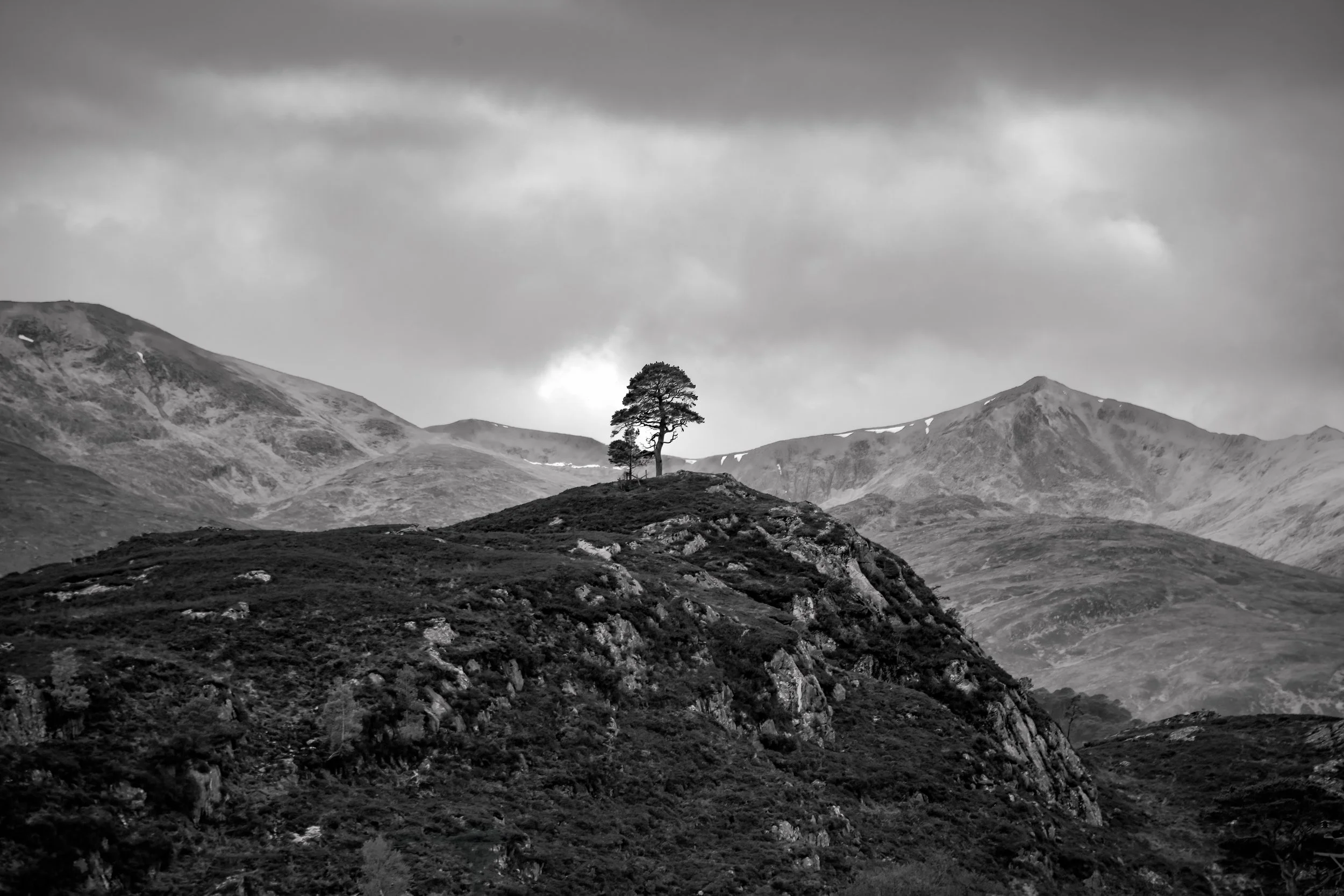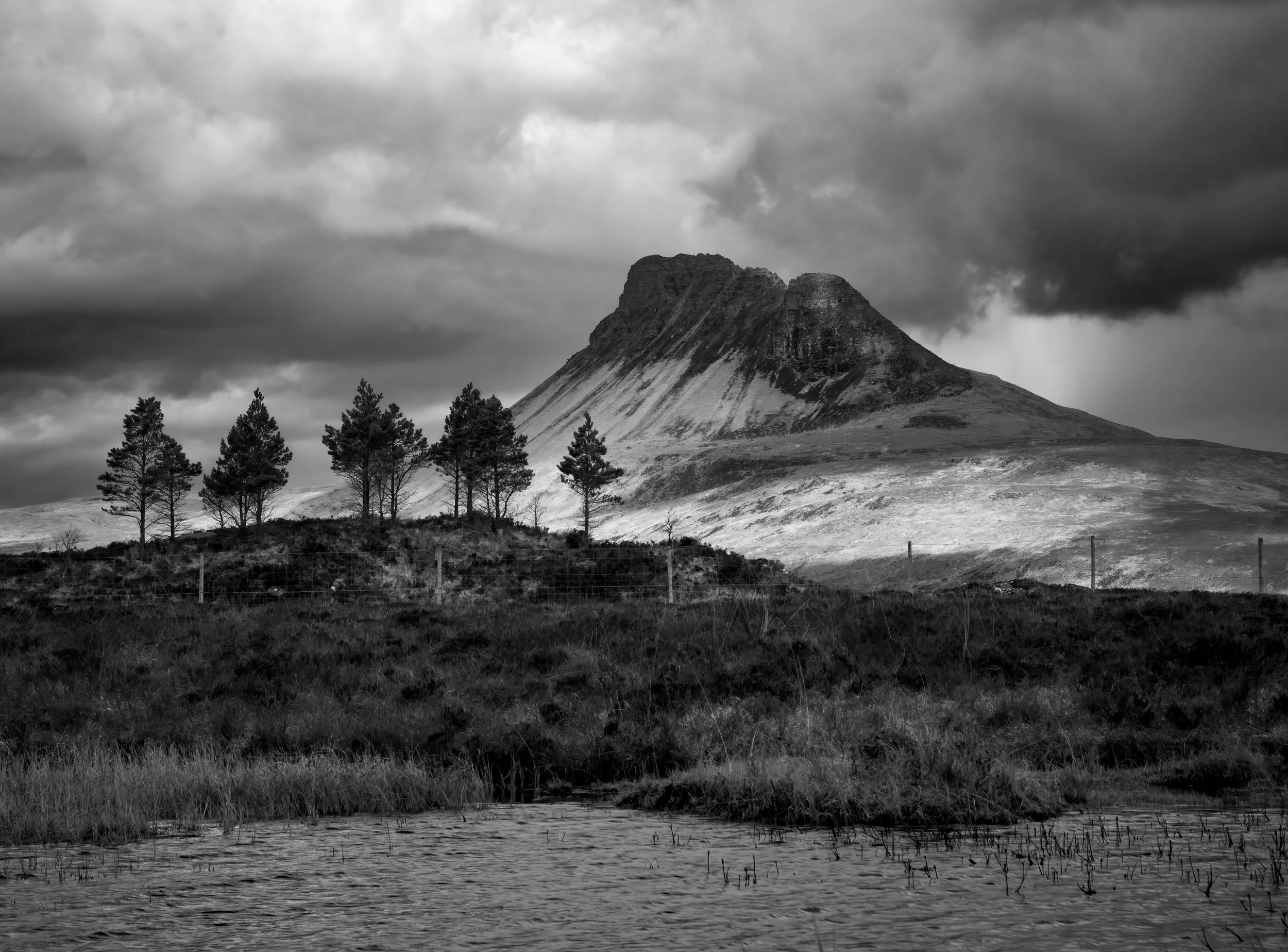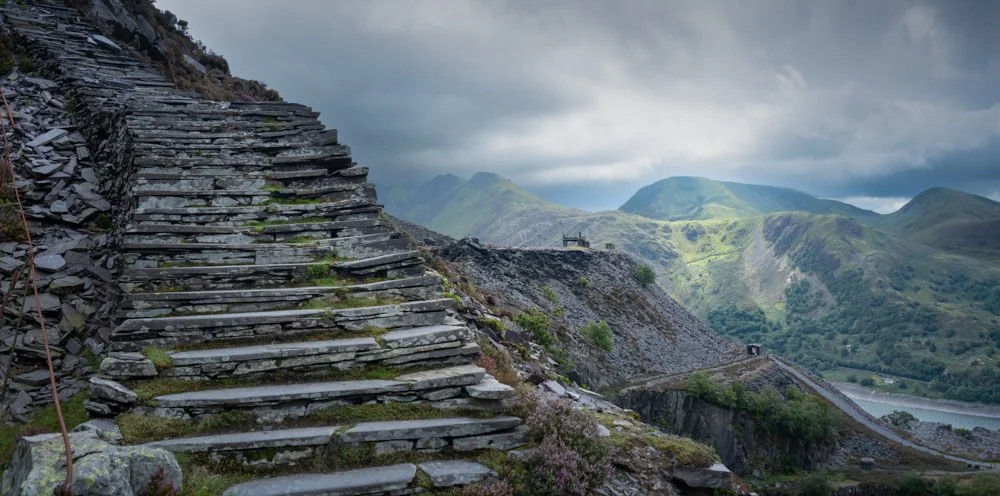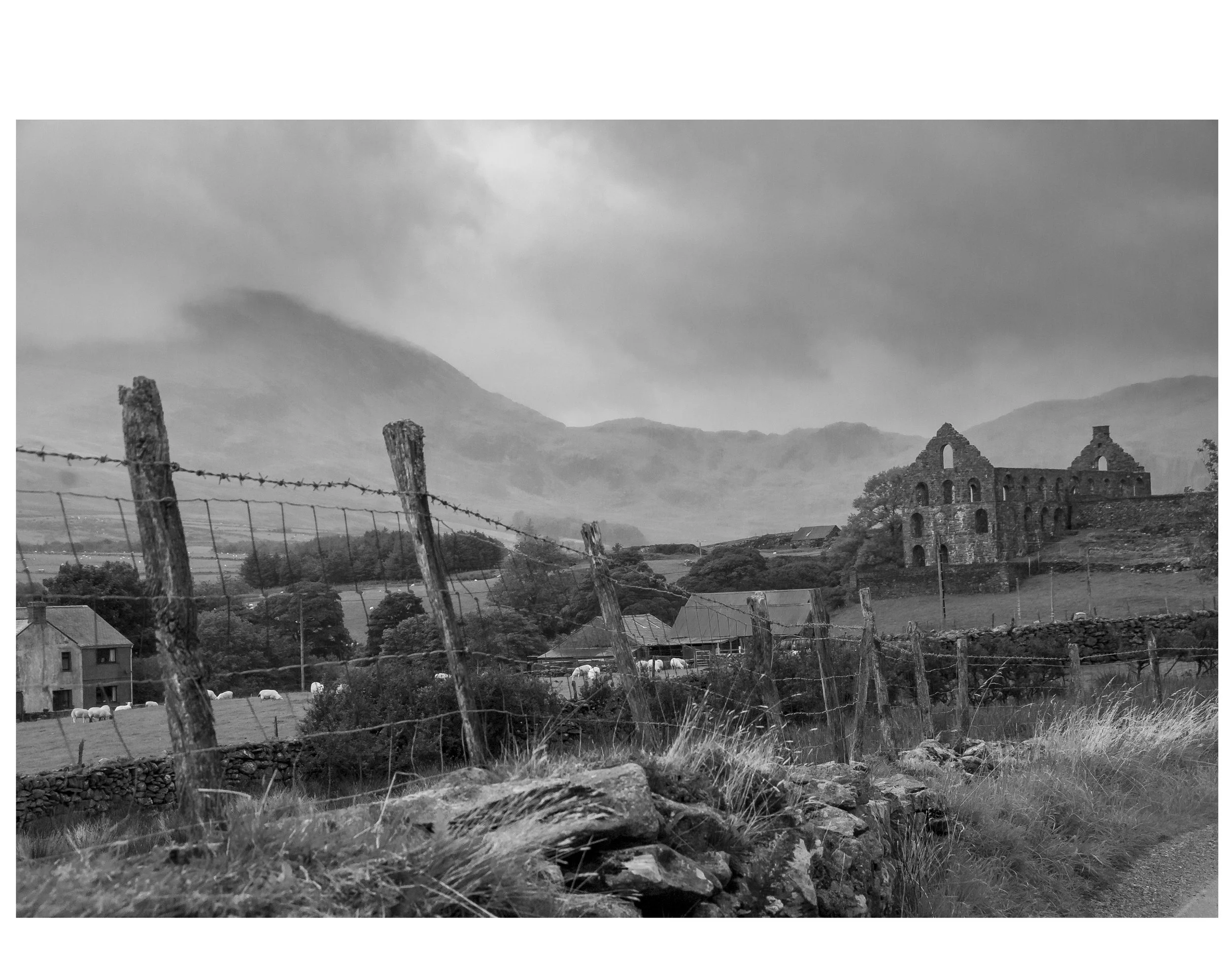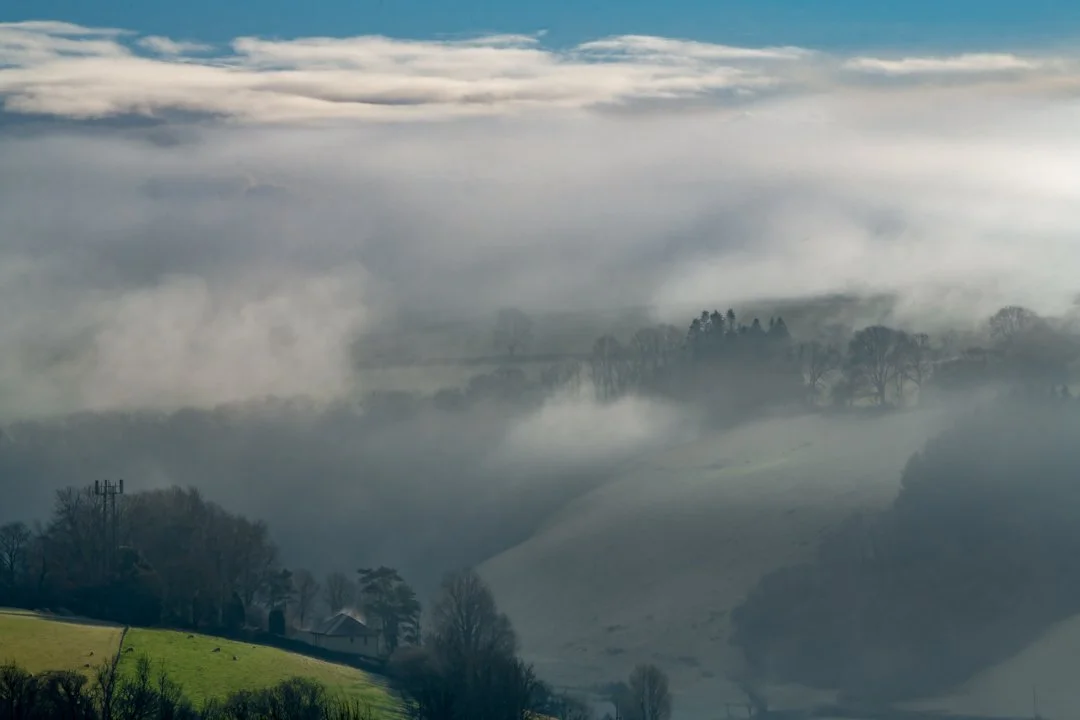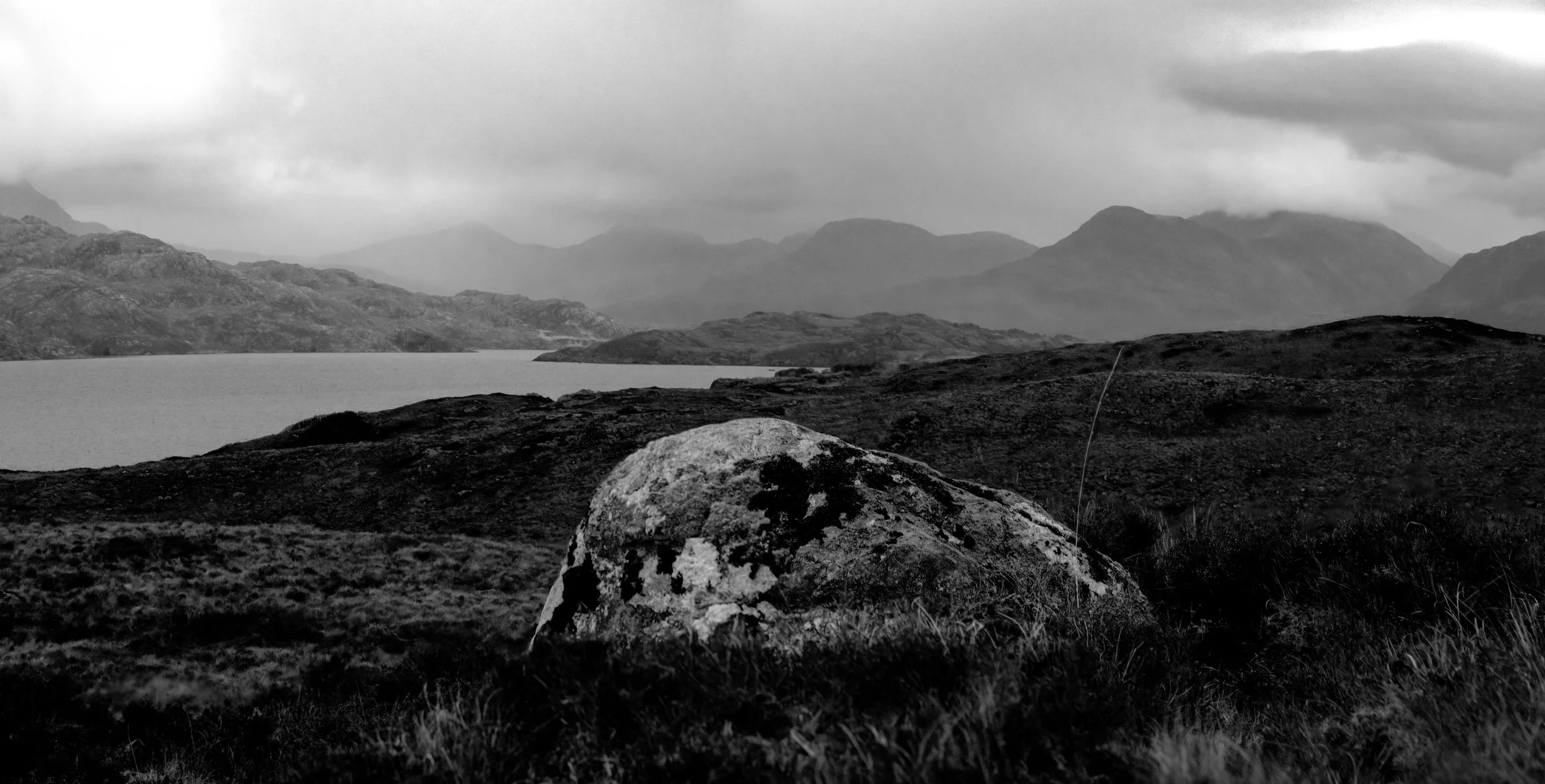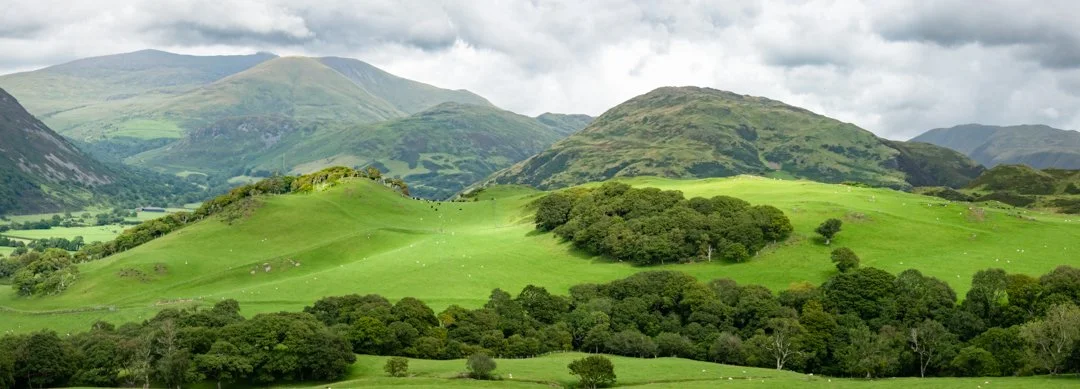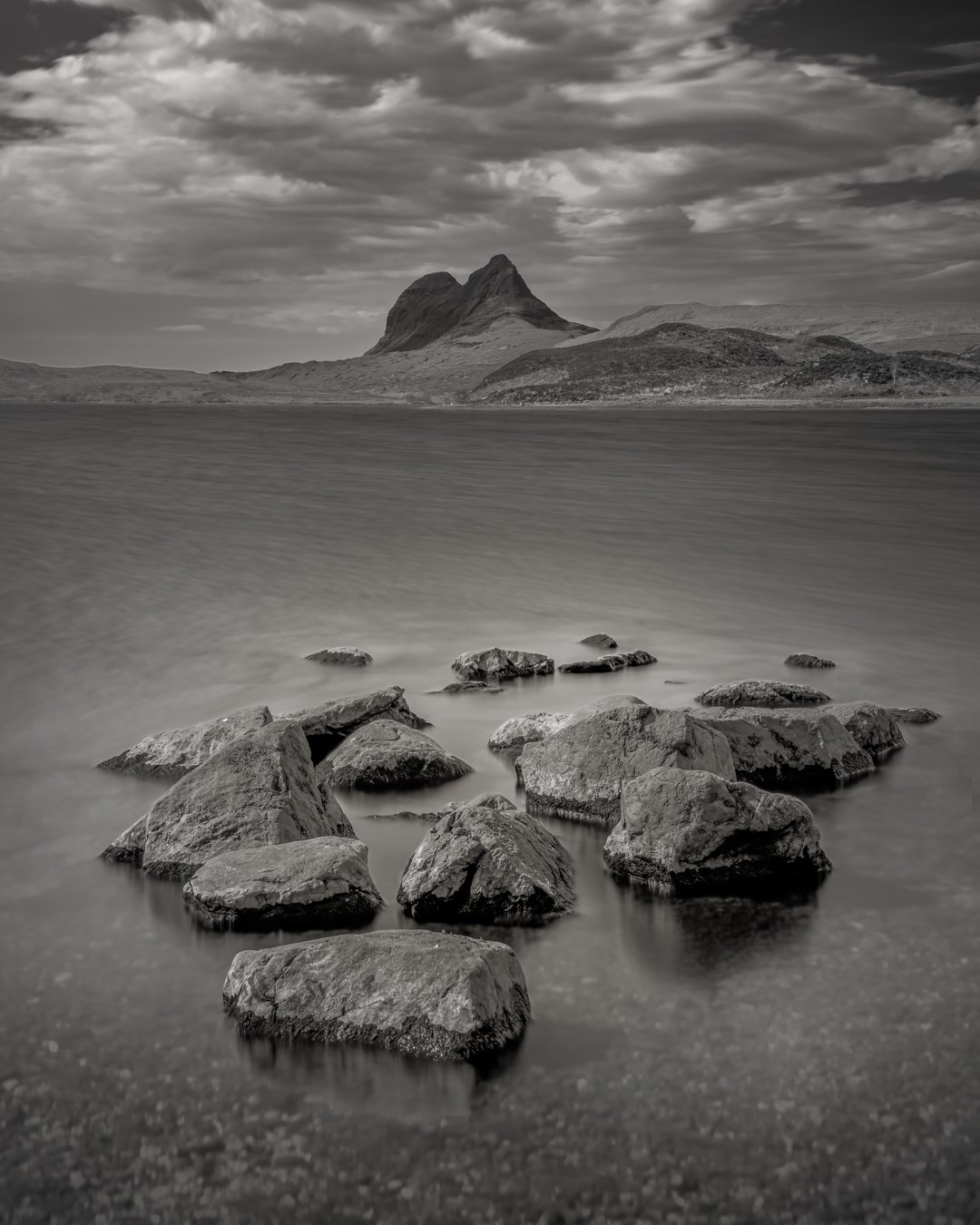MOUNTAINS AND HILLS
“The greatest gift of life on the mountain is time. Time to think or not think, read or not read, scribble or not scribble—to sleep and cook and walk in the woods, to sit and stare at the shapes of hills.”
On my visit to Glen Afric in May 2025 I fell into conversation with a local gentleman who was out on the loch in his kayak. He agreed with me on how beautiful the glen was, but that it was now having to cope with very high visitor numbers; “however,” he said, “there are a couple of equally beautiful parallel glens nearby which are not so well-known”, and he in particular recommended Glen Strathfarrar. Like so much local advice this was spot-on! In order to get into the glen, you need to register your car as you enter and agree to be out by early evening. Straight away I could see I was entering a paradise: beautiful woodlands, streams, rock formations, hills on each side becoming steeper and higher the further one went up the glen. It was totally enchanting. Some way up I spotted this Scots Pine atop a hill. I’m not usually one to get unnecesarily overexcited by a “lone tree” (unlike almost every other landscape photographer I know of!), but I could see a fairly epic photo here which showcased the hills and mountains of the glen and conveyed a real sense of place. The main thing here was getting the ideal visual relationship between the tree, the hill whose top it is on, and the background mountains. By moving closer or further I could make the tree above the distant horizon, below it, or, as I finally decided, intersecting it near its base. This was always going to be a monochrome image with the tree silhouette, the different shades of grey for the overlapping layers of hills, and the patterns on the hills caused by the rocks and vegetation. To get this image, a considerable zoom was needed; however, this also helps to achieve the effect I wanted, as it “compresses” the distance between the various elements to help create a unified image.
Stac Pollaidh (Stac Polly) in the Assynt wilderness North of Ullapool has an unforgettable profile that makes it look like the backdrop to a scene from “Lord of the Rings”; it rises alone from the landscape, topped with some of the most jagged rocks you’ll find on a Scottish mountain. On my visit in 2024 I decided to explore some new views of the mountain. Parking the van I wandered “off piste” amid the lochans and reeds of the base of the valley, getting somewhat bogged down in the marshy ground. Although I got an image with water and reeds in the foreground that I am pleased with, I am most pleased with the one above, with the row of trees in the mid-ground. The sun was in and out but with a largely cloudy sky, and I waited for the ideal combination of light and shade to be “painted in” by these moving patches of light. Having the sweeping slopes of the mountain lit up, with a dark foreground and trees so dark that they are more like a silhouette, gave me that sense of grandeur at the same time as a feeling of foreboding, which was how I felt about the mountain on that dark and unsettled day.
Mountain slopes in Glen Strathfarrar. More of an abstract photo. What particularly made this for me was the strong line of sunlight at the edge of foreground slope, echoed by the nearer line of semi-sunlight. To me the lines sloping downwards towards the right seemed to fit with the darker mass of mountain in the centre. The lighter sky on the right acts somewhat as a counterbalance. I enjoy looking at the overall design of this image, and its flowing lines. This was a hand-held image and a spontaneous reaction to some lovely fleeting light.
I am always moved and humbled when I visit Dinorwic slate mine in the heart of Eryri (Snowdonia). At its height tens of thousands of miners worked here at what was the second largest of its kind in the world. There is a haunting quality to the remains of buildings, train tracks, caves, huge mounds of slate, stairs and abandoned equipment. This was an incredibly hard life for those who worked here, and a dangerous one. I was thinking that I had done well to climb all the various levels of the mine up to a high point on the mountain; yet these miners would have to do exactly the same every day, and once at the top they had to do a long day’s work and then descend; I was only taking my time and creating photos! This photo shows the staircase which rises steeply from one level to the next, as well as the building right in the centre on the ridge with an illuminated mountainside behind. I wanted the elegant lines of the sides of the stairs, winding up and to the left, to be complemented by those of the mid-ground and the more distant hills. The view of a slice of Llyn Padarn at the bottom right gives a sense of how high the mine is above the valley floor. The grey and moody weather helped in creating a sense of the place and its history, and a memory for all those who worked here in such hard conditions.
Ynyspandy slate mill, Llanfihangel-y-Pennant, on the western fringe of Eryri, is, like Dinorwic, wonderfully evocative of the region’s past. This image was taken many years ago. and much later I decided to return. Foolishly I had not made a note of its location and it took a long time to re-locate it, which I did eventually after several attempts: I had formed the idea of going back and trying to reproduce this exact image on my more professional camera and lens - I’d been very happy with the original composition, but felt I could get a higher image quality. But, as I have heard many say, you can’t reproduce an image; you, the photographer, will be different and see things in a different way; and the conditions will always be different. But I thought I would try, and had a copy of the original photo. I have to say that I got quite close, but in the end, I didn’t manage to surpass the original image, partly because the half-mist in which the background hills are veiled was not there; and nor were the sheep in the field; so the sense of modern farm life in the wake of the old ruin is not so strong; and the almost claustrophobic sense at the head of this lonely valley is not as apparent. Plus although the fence was still standing, its angles were very slightly different and that effected the composition subtly to its detriment. So, with “warts and all” here is the original image, which remains one of my favourites, I have to say! And, YES, don’t try to recreate an old picture exactly.
Carmarthenshire is a large county in West Wales, and one where I have my home. It is hugely varied, with a coastline of beautiful beaches, mountains which form the Western part of the Brecon Beacons, miles and miles of rolling countryside with farms and woodland co-existing, and many glorious river valleys, the Tywi and Teifi being but two. In this image of the hilly countryside near Cynwyl Elfed, mist from the valley of the river Gwili hangs above the fields and woodland. A very typical scene from the area in which I live.
On my arrival in Torridon back in 2019 in stormy conditions, I headed to the village of Inver Alligin on the shores of Loch Torridon. The mountains opposite, including Beinn Damh and Sgorr Ruadh, looked spectacular. I could see a good image which included the waves running over the foreground rocks at the edge of the water, but the problem with this kind of photo is that it can be ruined by a large and rather featureless mid-ground of the expanse of the loch itself. The solution in cases like this is to get very low, as near to the ground as possible, thereby reducing the “real estate” of this midground: in this case getting uncomfortable and wet amid the jagged rocks and seaweed; ah well, but when you can get a good image it’s all worthwhile.
The Torridon peaks in stormy mood, looking over Loch Torridon from the south. I’d just arrived in the area via the iconic Applecross Pass. It was nearly time to look for somewhere to camp out for the night, but I couldn’t stop looking at the brooding view of the mountains; I’d known and loved these particular mountains for many decades, having climbed the main peaks of Beinn Eighe, Alligin and Liathach as a late teenager. Returning always gives me a special sense of excitement. As the light begun to fall, I noticed some way off a rather shapely rock in the middle of the scrub. I straight away saw that it would be an ideal foreground for a panoramic photo: it isn’t enough just to give a photo some “foreground interest” - the foreground and subject must in some sense reference each other, and in this case it is like the rocks of the mountains seen close-up, it shows what the mountains are made of. I wasn’t sure whether to remove the long wisp of grass at the right of the rock: was it an untidy distraction? In the end I thought I’d leave it in, but with modern editing techniques it would be so easy to remove if I changed my mind about this. There’s a whole discussion amongst landscape photographers on the whole matter of “cloning things out” and whether that’s acceptable, and plenty of arguments on each side!
Craig yr Aderyn, or Bird Rock, is a high outcrop looking out over the Dysynni valley near Cadair Idris in Southern Eryri (Snowdonia), home to cormorants and choughs. It’s a good hour’s walk from the road to the summit with spectacular views at all times. The shapes of the hills and mountains behind them, the patterns made by the woodland and green meadows, all of these are rich pickings for anyone with a camera. The day I was there provided ideal conditions with interesting cloud formations and patches of sunlight which appeared and disappeared, illuminating different parts of the hills and distant mountains. This picture, taken about 2/3 of the way up, shows the sunlight lighting up the gorgeous green meadows in a way that picked out its contours perfectly.
My trip to the North West Highlands of Scotland in April/May 2024 started off fighting to regain my strength after a fairly severe bout of Covid. Having spent time in the far North at Durness, I drove a round trip via Lairg back to the Assynt region. As I drove Westwards, the familiar profile of Suilven emerged. Like all the Assynt peaks, Suilven stands alone and majestic. Being a very long way from any road it isn’t a peak that can easily be climbed in a single day. Although very well-known to anyone familiar with Scottish mountains, it became known to a much wider audience with the film “Evie”, featuring a recently widowed old lady who determines to climb it; it’s a lovely film, featuring Sheila Hancock. One way to approach the mountain is by kayak, on a long thin loch (Loch Veyatie) which eventually takes you to near the base of the mountain. On this occasion I realized from the map that I was very near the beginning of this loch, and I might be able to get an interesting photo of Suilven using the loch as a foreground. I took my gear onto what I thought was a path, but this rapidly petered out, after which I stumbled over very uneven and boggy ground and hidden rocks under the scrub, and eventually reached the loch: I was totally exhausted, still very weakened post-Covid. It took me some while to find a picture I was happy with - a wide-angle lens placed low and very close to the collection of rocks in the water meant I could frame the mountain nicely with a very long exposure picture. From the moment I saw this opportunity I knew it would favour a black-and-white interpretation.
This is such a long panorama (and I don’t want to crop it) that even on a biggish screen it looks quite small, but it’s one of my images that I’d most like to see printed out as an enormous print about six feet long or more. I love this image, taken from the slopes of Cnicht of Yr Wyddfa (Snowdon) and the main central Eryri area. I’d thought I would climb Cnicht, which is a favourite of mine and never overcroded, but the rain came lashing down relentlessly. Despite the appearance of a group of student cartographers I still managed to get lost, and in the end thought I would spend the time photographing the westerly view. I was richly rewarded with incredibly dramatic light and cloud formations over yr Wyddfa. I took many sets of images with different light and cloud conditions, but the one above remains my firm favourite. Despite its long aspect ratio, I thing the structure of the photo is still strong, and the features of the light throughout the image apparent to the viewer.
